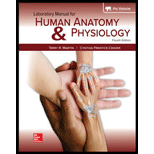
Concept explainers
The abdominal wall muscles possess the following functions except
a. extend the spine.
b. compress the abdominal visceral organs.
c. assist in forceful exhalation.
d. help maintain posture.
Introduction :
The muscles are the bundles of the fibrous tissues in the animals that have the ability to contract, movement, and maintaining the position of different parts of the body. There are three types of muscles, smooth, cardiac, and skeletal muscles. The muscular system is controlled by the nervous system and some muscles are autonomous.
Answer to Problem 2PL
Correct answer :
Option (a), extend the spine.
Explanation of Solution
Explanation/justification for the correct answer :
Option (a) is extend the spine. The deep back muscles help in the extension of the spine and maintain the body posture. Hence, this option is correct.
Explanation for incorrect answer :
Option (b) is compress the abdominal visceral organs. The abdominal wall muscle compresses the abdominal visceral organs against the diaphragm. Hence, this option is incorrect.
Option (c) is assist in forceful exhalation. As the abdominal wall muscle push back the abdominal visceral organs against the diaphragm, it results in forceful exhalation. Hence, this option is incorrect.
Option (d) is help maintain posture. The abdominal wall muscle also helps in maintaining the body posture. Hence, this option is incorrect.
Want to see more full solutions like this?
Chapter 24 Solutions
Laboratory Manual For Human Anatomy & Physiology
- (a) What muscles develop from the embryonic structures called somitomeres? (b) What are the major groups of pharyngeal arch (branchiomeric) muscles? (c) What three constrictor muscles squeeze swallowed food through the pharynx to the esophagus?arrow_forwardDescribe the muscles of the anterior neck.arrow_forwardThe function of the biceps femoris is to A. flex the hip and ankle. B. extend the thigh and flex the leg. C. flex the thigh and extend the leg. D. flex the thigh (with no action at the leg). E. adduct the thigh and extend the knee.arrow_forward
- The two main muscles that point the toes are the _____. A tibialis anterior and extensor digitorum longus B tibialis anterior and vastus medialis C adductor longus and adductor brevis D soleus and gastrocnemiusarrow_forwardName the muscles in the neck and list the origin,insertion, and action of each.arrow_forwardWhich of the following muscle does not laterally rotate the thigh. a) obturatorius internus muscle b) gemellus inferior muscle C) Priformis muscle D) gluteus minimus muscle F) gemellus superior musclearrow_forward
 Fundamentals of Sectional Anatomy: An Imaging App...BiologyISBN:9781133960867Author:Denise L. LazoPublisher:Cengage Learning
Fundamentals of Sectional Anatomy: An Imaging App...BiologyISBN:9781133960867Author:Denise L. LazoPublisher:Cengage Learning Anatomy & PhysiologyBiologyISBN:9781938168130Author:Kelly A. Young, James A. Wise, Peter DeSaix, Dean H. Kruse, Brandon Poe, Eddie Johnson, Jody E. Johnson, Oksana Korol, J. Gordon Betts, Mark WomblePublisher:OpenStax College
Anatomy & PhysiologyBiologyISBN:9781938168130Author:Kelly A. Young, James A. Wise, Peter DeSaix, Dean H. Kruse, Brandon Poe, Eddie Johnson, Jody E. Johnson, Oksana Korol, J. Gordon Betts, Mark WomblePublisher:OpenStax College Medical Terminology for Health Professions, Spira...Health & NutritionISBN:9781305634350Author:Ann Ehrlich, Carol L. Schroeder, Laura Ehrlich, Katrina A. SchroederPublisher:Cengage Learning
Medical Terminology for Health Professions, Spira...Health & NutritionISBN:9781305634350Author:Ann Ehrlich, Carol L. Schroeder, Laura Ehrlich, Katrina A. SchroederPublisher:Cengage Learning




